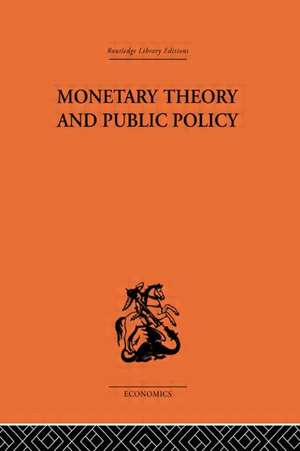Monetary Theory and Public Policy
Autor Kenneth K. Kuriharaen Limba Engleză Paperback – 19 oct 2010
| Toate formatele și edițiile | Preț | Express |
|---|---|---|
| Paperback (1) | 305.94 lei 43-57 zile | |
| Taylor & Francis – 19 oct 2010 | 305.94 lei 43-57 zile | |
| Hardback (1) | 1185.83 lei 43-57 zile | |
| Taylor & Francis – 5 iun 2003 | 1185.83 lei 43-57 zile |
Preț: 305.94 lei
Preț vechi: 352.34 lei
-13% Nou
Puncte Express: 459
Preț estimativ în valută:
58.56€ • 63.63$ • 49.22£
58.56€ • 63.63$ • 49.22£
Carte tipărită la comandă
Livrare economică 21 aprilie-05 mai
Preluare comenzi: 021 569.72.76
Specificații
ISBN-13: 9780415607834
ISBN-10: 0415607833
Pagini: 410
Dimensiuni: 138 x 216 x 24 mm
Greutate: 0.76 kg
Ediția:1
Editura: Taylor & Francis
Colecția Routledge
Locul publicării:Oxford, United Kingdom
ISBN-10: 0415607833
Pagini: 410
Dimensiuni: 138 x 216 x 24 mm
Greutate: 0.76 kg
Ediția:1
Editura: Taylor & Francis
Colecția Routledge
Locul publicării:Oxford, United Kingdom
Public țintă
Postgraduate and ProfessionalCuprins
1. Introduction: The Significance of Monetary Analysis and Policy PART I 2. The Internal Value of Money · The Quantity Theory of Money · Determinants of Transaction Variables · An Evaluation of the Transaction Theory · The Income-Flow Equation of Exchange · Cash-Balance Equation of Exchange 3. Creation and Destruction of Money · Creation of Bank Credit · Multiple Credit Expansion By The Banking System · The Destruction of Bank Credit · The Creation and Destruction of Money by the State 4. The Theory of Inflation · Concept of the Inflationary Gap · Inflation and Full Employment · Analysis of Inflationary Pressures · Effects of Inflation · Inflationary Boom and Bust · Inflation and Deflation 5. Anti-Inflation Policies · Monetary Measures · Fiscal Measures · Nonmonetary Measures PART II 6. The Liquidity-Preference Theory · Liquidity-Preference · Liquidity-Preference Theory of Interest · The Interest Rate and Investment 7. Interest Policy and Full Employment · Rationale of the Low Interest Rate · Some Deterrents to Low-Interest Policy 8. Non-Keynesian Theories of Saving and Investment · Classical Savings-Investment Theory · Under consumption Theory 9. Aggregate Demand and National Income · Aggregate Demand and Employment · Concept of Gross National Product 10. The Consumption Function · Concepts of the Propensities to Consume and to Save · Some Relevant Implications of Keynes' Law · Factors Affecting the Consumption Function 11. Savings and Investment · Savings-Investment Equilibrium · Underemployment Equilibrium · Determinants of Investment 12. The Multiplier and Acceleration Theories · The Multiplier Theory · The Acceleration Theory 13. Secular Underemployment Equilibrium · Statement of the Problem · Factors of Secular Over saving · Factors of Secular Under investment 14. Measures to Promote Investment · Modification of the Corporate Income Tax · 'Pump Priming' · 'Compensatory Spending' · Wage Reduction · Credit Policy · The Reservoir Plan 15. Measures to Raise the Consumption Function · Income Redistribution · Wage Policy · Social Security · Easy Consumer Credit · Other Measures for a Higher Consumption Function 16. Epilogue on Full Employment PART III 17. The External Value of Money · Stable Exchange Rates · Specie-Flow-Price Mechanism · Devaluation 18. The External Value of Money · The Purchasing Power Parity Theory · Basic Defects of the Parity Theory · The Balance-of-Payments Theory of Exchange Rates · The Manipulation of Exchange Rates 19. The International Monetary Fund · Keynes' Basic Proposals · The Fund and Exchange Rates · The Fund and Exchange Control · The Fund's Lending Operations 20. Monetary Sovereignty and International Equilibrium · The Specialization vs. Payment Approach · The Mechanism of International Spread of Depression · A 'Chronic Shortage of Dollars' · Principles and Instruments of Monetary Sovereignty 21. Foreign Investment, The World Bank, and Employment · Foreign Investment and Cyclical Unemployment · Foreign Investment and Secular Stagnation Conclusions
Descriere
Providing an extensive examination of monetary theory and its implications for public policy, this book is as relevant for an understaning of current economic problems as when it was first published.













